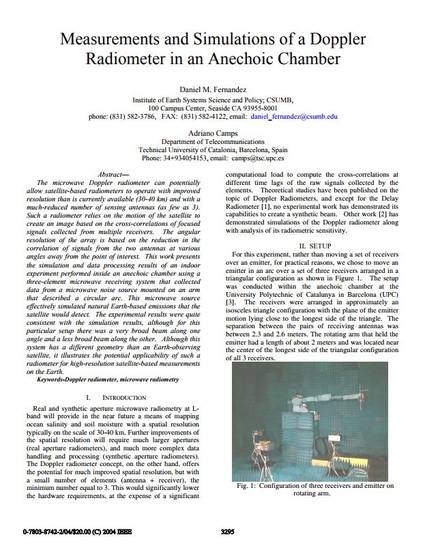
Article
Measurements and Simulations of a Doppler Radiometer in an Anechoic Chamber
2004 IEEE International Geoscience and Remote Sensing Symposium
(2004)
Abstract
The microwave Doppler radiometer can potentially allow satellite-based radiometers to operate with improved resolution than is currently available (30-40 km) and with a much-reduced number of sensing antennas (as few as 3). Such a radiometer relies on the motion of the satellite to create an image based on the cross-correlations of focused signals collected from multiple receivers. The angular resolution of the array is based on the reduction in the correlation of signals from the two antennas at various angles away from the point of interest. This work presents the simulation and data processing results of an indoor experiment performed inside an anechoic chamber using a three-element microwave receiving system that collected data from a microwave noise source mounted on an arm that described a circular arc. This microwave source effectively simulated natural Earth-based emissions that the satellite would detect. The experimental results were quite consistent with the simulation results, although for this particular setup there was a very broad beam along one angle and a less broad beam along the other. Although this system has a different geometry than an Earth-observing satellite, it illustrates the potential applicability of such a radiometer for high-resolution satellite-based measurements on the Earth.
Keywords
- Doppler radiometer,
- microwave radiometry
Disciplines
Publication Date
2004
DOI
10.1109/IGARSS.2004.1370407
Citation Information
Daniel Fernandez and Adriano Camps. "Measurements and Simulations of a Doppler Radiometer in an Anechoic Chamber" 2004 IEEE International Geoscience and Remote Sensing Symposium Vol. 5 (2004) Available at: http://works.bepress.com/daniel-fernandez/8/
